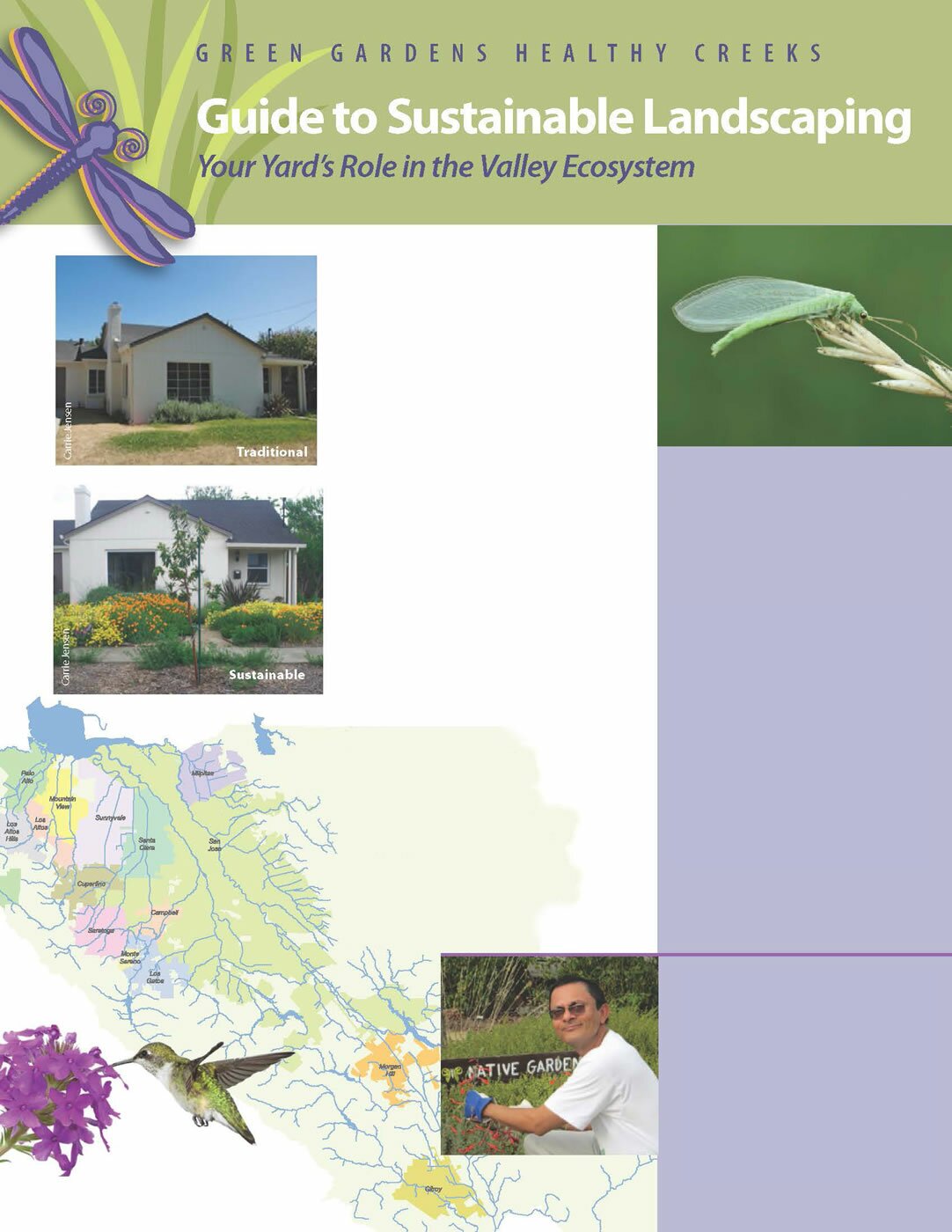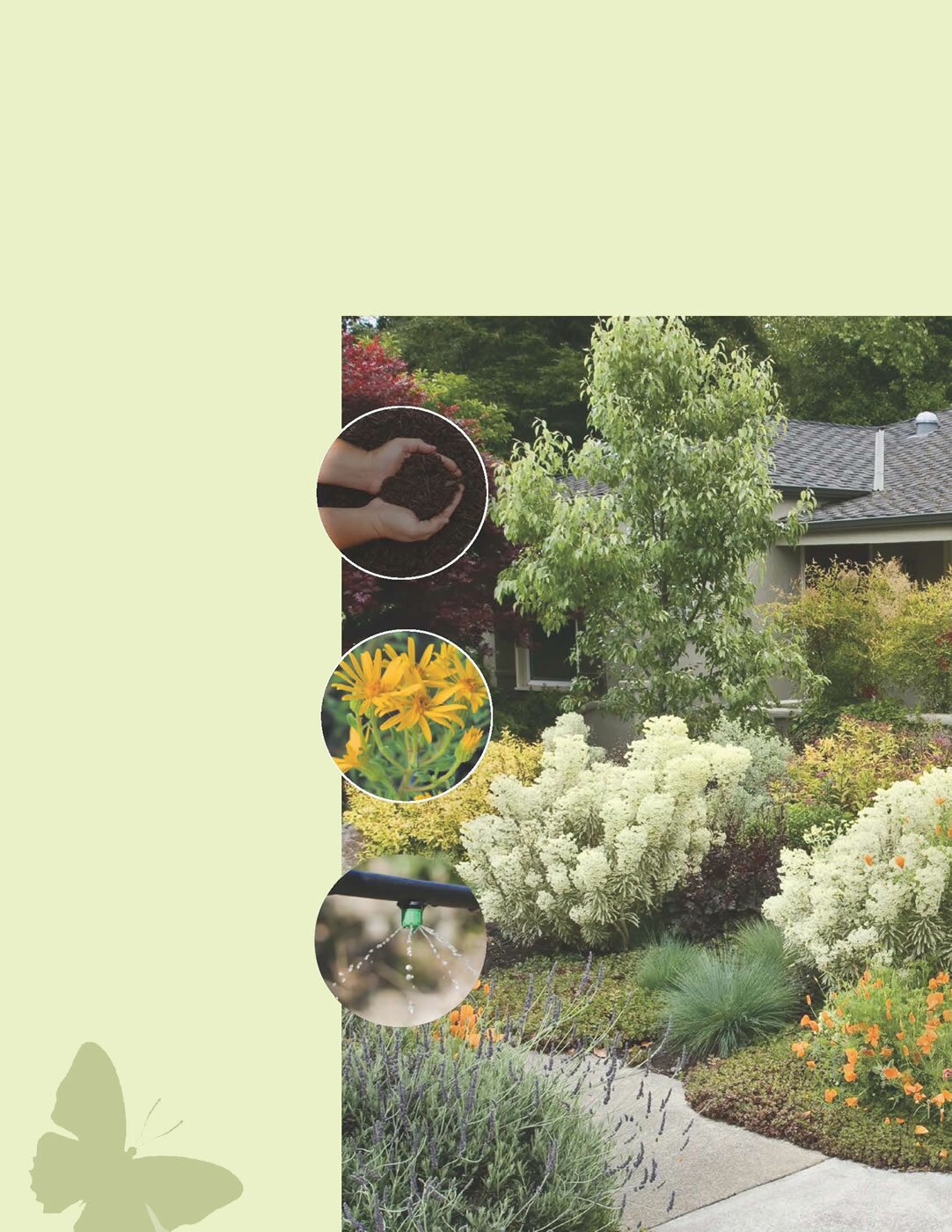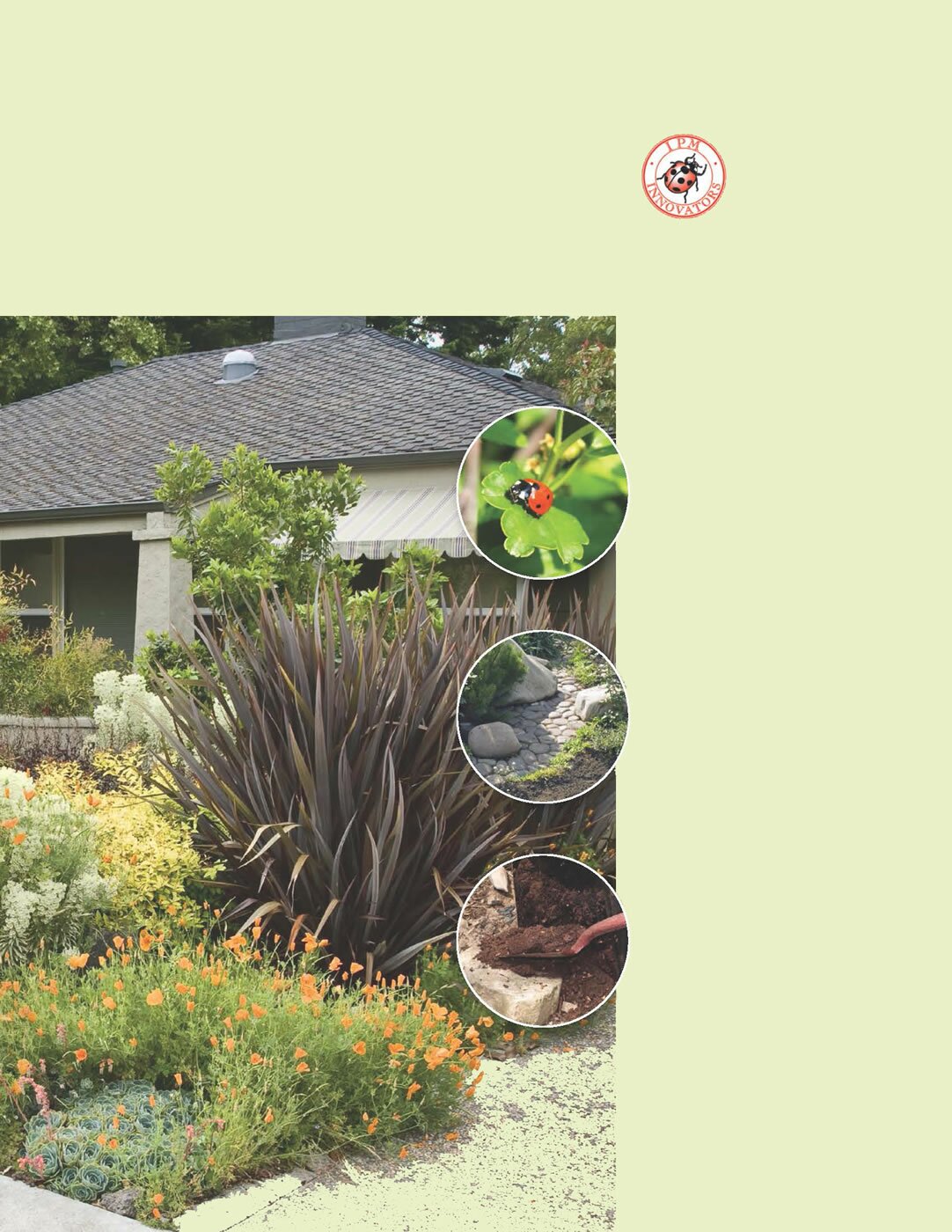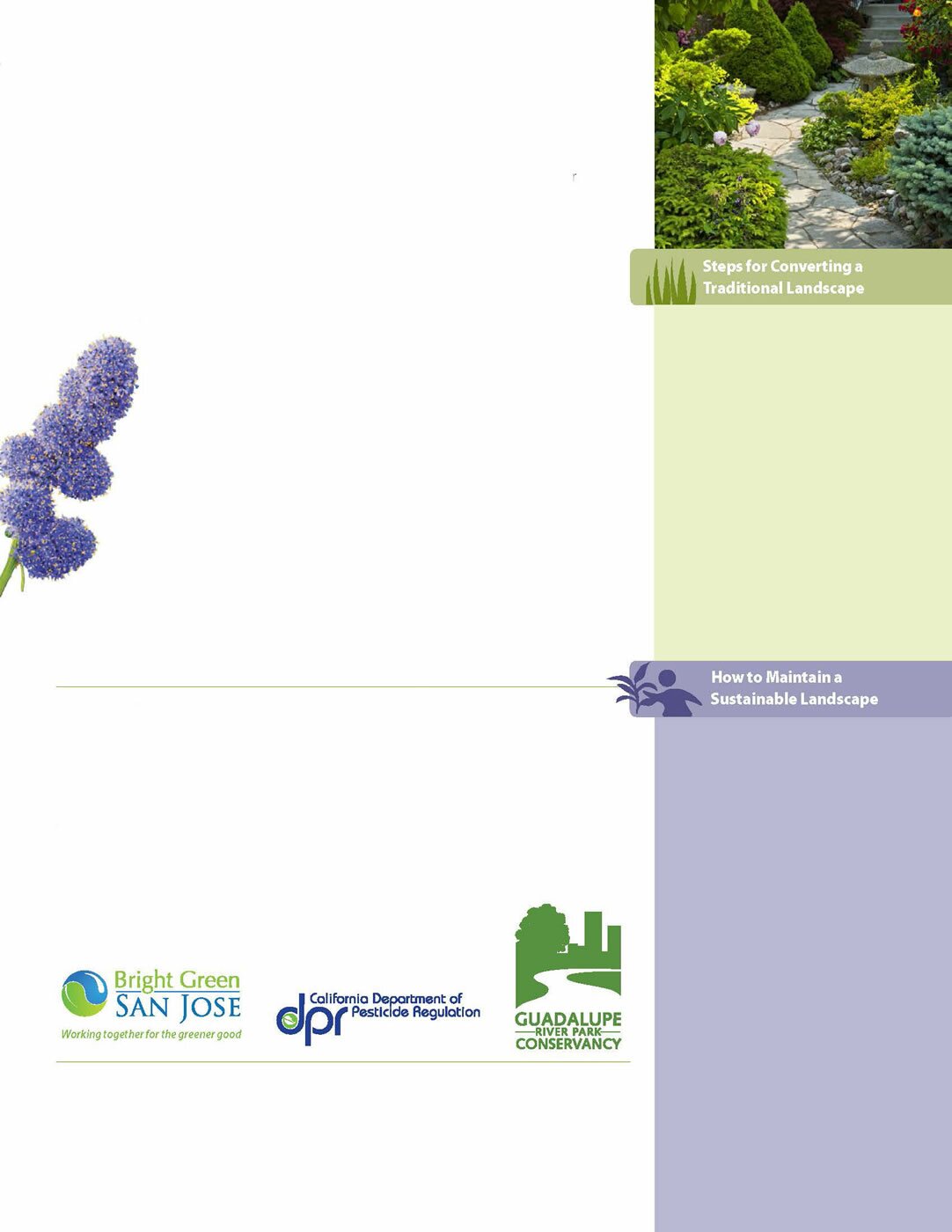
What is Sustainable Landscaping?
Sustainable landscaping is the use of design and maintenance practices that work harmoniously with your local climate and soils. A sustainable landscape is adapted to your area’s rainfall patterns and can thrive with minimal watering. A sustainable landscape typically does not require pesticides or fertilizers and creates little or no waste.
In contrast, conventional landscapes may feature plants that need lots of water or may need gasoline-powered equipment to look groomed. Conventional landscapes may rely on pesticides and fertilizers to promote healthy growth. Rain or excess irrigation water can transport these chemicals down street gutters and into storm drains, which empty directly into the nearest creek and the San Francisco Bay. Such pollution is harmful to fish, wildlife, and our own quality of life.
A yard in step with the Santa Clara Valley Ecosystem
This guide provides the steps to convert all or a portion of your yard to a sustainable landscape that reflects the natural conditions of the Santa Clara Valley. We emphasize native, drought-tolerant plants that can thrive with either wet or dry years and that do well in our clay soils. Using these practices, you can enjoy a beautiful, economical yard that is easy to maintain — and that doesn’t pollute nearby creeks.
Beneficial insects like this Green Lacewing need non-toxic gardens to thrive and provide natural pest control
Cost-savings and benefits of sustainable landscaping
Harmonizing your yard to local conditions may save you money on…
- your water bill
- purchases of pesticides and fertilizers
- energy for power equipment
and create a healthier yard by …
- reducing noise and air pollutants
- avoiding toxic pesticides
- providing habitat for birds, butterflies, and beneficial insects
“Collectively, our yards are an important part of the valley ecosystem. I enjoy knowing that my sustainable garden of native plants is in harmony with natural conditions and provides a healthy place for my family, friends, and wildlife.”
Arvind Kumar, President, California Native Plant Society, Santa Clara Valley Chapter

How to Create a Sustainable Landscape
Start with Healthy Soil
Healthy soil supports healthy plants that resist pests, disease, drought, and other stresses. Applying compost and mulch and allowing soil organisms to thrive by avoiding pesticides will foster a healthy soil. The organisms will break down the compost, mulch, and plant clippings into vital nutrients. Plants that are nourished by these nutrients remain vigorous and naturally pest-resistant.
Right Plant in the Right Place
Different plants have different needs. Select plants to suit the soil, sunlight, and space in your yard. Plants need enough space to reach full size without frequent pruning. By placing plants in the right place, they will thrive naturally, remain healthy, and reduce the time needed for upkeep.
Water Wisely
Some plants tolerate a range of watering conditions; some are more sensitive. Watering too much or too little can weaken the plant. As stated above, grouping plants with similar watering needs makes it easier to provide the right amount of water. To optimize water use, deliver it near the roots. Drip and other smart irrigation methods deliver water directly to roots, allowing no excess water for weeds.
Use Smart Pest Management
There are several approaches to natural pest and weed management that - when used together (integrated) - can help avoid the need for pesticides and herbicides. Selecting plants adapted
to our climate is the first step to avoid problems with pests, weeds, or disease.
Other approaches include:
- Use cultural controls such as removing irrigation water and fertilizer from areas where you don’t want weeds to grow.
- Less-toxic herbicides such as herbicidal soaps and vinegars can be used as a last resort.
- Use physical controls such as manual removal with tools, smothering weeds with a mulch barrier.
- Use biological controls, such as selecting competitive, desirable plants that make it hard for weeds to grow, or attracting beneficial insects to control insect pests.

A patchwork of native flowering plants and grasses will attract beneficial insects to your yard by providing food and habitat for them. Note that you’ll have to tolerate a low level of pests in order to attract their predators. Consider changing your perspective: If you envision your yard as a meadow with multiple grass species and a few noninvasive weeds, you can resist reaching for chemical herbicides.
City of San José:
the IPM Innovator
Award Winner 2010.
All these techniques together are called “Integrated Pest Management” or IPM. For more information about IPM, visit the University of California Davis website.
Slow the Flow of Rainwater
Your yard can actually retain and clean rainwater. Capturing and storing rainwater reduces the need for irrigation with precious drinking water. Using pervious pavement, rain gardens, swales, or dry creek beds, you’ll help the ground soak up rainfall and reduce the amount that runs off and into a street gutter. These features may also add a unique, creative look to your landscape.
Conserve Energy and Reduce Greenhouse Gases
Your yard can help fight climate change! Healthy soil stores more carbon. Lowmaintenance, properly spaced plants require little or no mowing and trimming with gas-powered equipment, and generate little yard waste to be hauled to landfills. This helps reduce the methane emissions (a potent greenhouse gas) at the landfill from decomposing yard waste. Reduced water use from a smaller lawn also means less energy is needed to pump, treat, and deliver irrigation water. In various ways, all the practices mentioned in this factsheet help toward the goal of reducing energy use and greenhouse gas emissions.

Frequently asked questions about Sustainable Landscapes
Q1: Aren’t sustainable landscapes expensive?
Answer: The installation costs of sustainable and conventional landscapes may be similar. However, a sustainable landscape is easier and less costly to maintain. To accommodate your budget, you can phase in the conversion, instead of doing the entire yard at once.
Q2: Will sustainable landscaping practices work for me?
Answer: Yes, nature has succeeded with sustainable landscaping and you can too!
Q3: Aren’t lawns easier to maintain than a garden?
Answer: Lawns require mowing, watering, pest control, fertilizing, and weeding — all adding up to a burden on the gardener with impacts to the environment. Gardens can be simple, and once established, need little maintenance.
Q4: Can I still have a lawn in my sustainable garden?
Answer: Lawns can be attractive and desirable for certain activities, such as providing open space for children and pets. Identify the portion of your lawn that you most frequently use and design around it. You may be able to replace much lawn with native plants that will enhance the beauty of your yard. Consider also that a native, drought-tolerant, low-maintenance grass meadow can be as enjoyable or more interesting than a conventional lawn.
- Eliminate or minimize lawn area
- Select plants based on the soil and lighting conditions of your yard
- Select drought-resistant California native or climate-adapted plants
- Group plants by their watering needs to make irrigation easy
- Use smart pest management
- Use pervious materials for walkways and patios
- Cover bare ground with mulch
- Plan for capturing and using rainwater
- Install a water-efficient irrigation system
- Feed the soil naturally with compost and mulch
- Make your own mulch and compost onsite using plant debris
- Avoid pesticides and synthetic fertilizers
- Protect soil from compaction and erosion
- Use graywater or captured rainwater when possible
Additional Resources
Santa Clara Valley Master Gardeners
Bay Friendly Landscape Guidelines
Reading List
Sustainable Landscaping For Dummies
by Owen Dell
Designing California Native Gardens
Glen Keator and Alrie Middlebrook
Rainwater Harvesting for Drylands and Beyond
Brad Landcaster
Funding for this project has been provided in full or in part through a grant awarded by the Department of Pesticide Regulation (DPR). The contents of this document do not necessarily reflect the views and policies of the Department of Pesticide Regulation, nor does mention of trade names or commercial products constitute endorsement or recommendation for use.
For more information about sustainable gardening, please visit www.bayareaecogardens.org